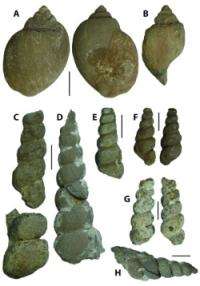Mass extinctions: 'giant' fossils are revolutionizing current thinking

(PhysOrg.com) -- Large-sized gastropods (up to 7 cm) dating from only 1 million years after the greatest mass extinction of all time, the Permian-Triassic extinction, have been discovered by an international team including a French researcher from the Laboratoire Biogéosciences (CNRS/Université de Bourgogne), working with German, American and Swiss colleagues.
These specimens call into question the existence of a “Lilliput effect”, the reduction in the size of organisms inhabiting postcrisis biota, normally spanning several million years. The team's results, published in the February 2010 issue of the journal Geology, have drastically changed paleontologists' current thinking regarding evolutionary dynamics and the way the biosphere functions in the aftermath of a mass extinction event.
The history of life on Earth has been punctuated by numerous mass extinctions, brief periods during which biodiversity is considerably reduced, followed by phases of re-conquest of the biosphere, corresponding to the diversification of those species that survived. Over the last 540 million years, around twenty mass extinctions, of greater or lesser intensity, have succeeded one another. The most devastating of these, the Permian-Triassic (P-T) mass extinction, which decimated more than 90% of the marine species existing at the time, occurred 252.6 million years ago with a violence that is still unequaled today.
In the aftermath of such events, environmental conditions are severely disrupted: the oceans become less oxygenated, water becomes poisonous, there is increased competition, collapse of food chains, etc. Until now, it has generally been accepted that certain marine organisms, such as gastropods or bivalves, were affected by a drastic reduction in size in response to major disruptions of this nature, both during and after the event. It took several million years for such organisms to return to sizes comparable to those that existed prior to the crisis. This is what scientists call the “Lilliput effect”, in reference to the travels of Gulliver who was shipwrecked on the island of the same name, inhabited by very small Lilliputians.
An international team of French, German, American and Swiss paleontologists has recently discovered large gastropod fossils dating from only 1 million years after the P-T mass extinction. The researchers have spent several years studying the re-conquest phase that followed the P-T crisis. By focusing their efforts on fossil-bearing outcrops in Utah dating from the Early Triassic, which have not yet been studied in detail, they have uncovered some outstanding specimens of gastropods, up to 7 cm, which can be termed as “giants” in comparison to those generally found, normally no bigger than 1 cm. Complementary studies of these new gastropod fauna also indicate that they are not any smaller than older or present-day fauna.
This discovery therefore refutes the existence of a Lilliput effect on gastropods during the major part of the Early Triassic or, at the very least, suggests that its importance has been overestimated.
Quite surprisingly, the presence of these large gastropods also coincides with an explosive re-conquest of the ocean by organisms such as ammonites (See also Brayard et al. 2009. Science 235: 1118-1121). Taken together, these events therefore suggest that restructuring of marine ecosystems was already well underway only one million years after the P-T crisis, a very short time after a mass extinction of such magnitude.
The researchers plan to continue to study the fossils discovered in this locality in Utah while searching for other species and groups, such as bivalves, to confirm this new data. However, these findings already suggest that paleontologists are going to have to re-think the immediate and long term impact of mass extinctions on species.
More information: Brayard A., Nützel A., Stephen D.A., Bylund K.G., Jenks J. and Bucher H. 2010. Gastropod evidence against the Early Triassic Lilliput effect. Geology, 38 (2): 147-150.
Provided by CNRS


















